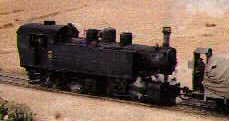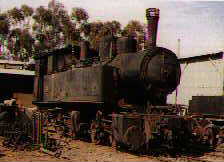|
Eritrean revival |
|||
|
For more background information please see The Eritrean Railway. This did threaten to become the steam story of the 90's with long stored Mallets being put back into service on the rehabilitated 950mm gauge railway. The Times of London carried a story about this again on Dec 21st 1996 apparently with a picture of one of the Mallets. (Click here for Ralph Reinhold's update.) I have checked this out on the Net Version - but the picture is not included. Here are some extracts: "Rusting steam trains have been brought out of old sheds, burnished, oiled and lovingly restored. Retired railwaymen have been mobilised. Next month President Afewerki of Eritrea will formally inaugurate the restoration of one of Africa's most spectacular narrow-gauge railways." "The first 30 miles of track are already in operation, and the entire 75-mile section, linking Asmara and Mussawa, is virtually repaired. The project has cost around £3 million." "Built in the 1890s, the line, with a gauge of just less than a metre, is one of the most extraordinary feats of colonial engineering. Twisting through gorges and over viaducts, it climbs almost 7,000ft above the hot coastal plain." "The line once ran for 221 miles, linking up with the Sudanese rail system (this is not true, it never got that far). But there is no likelihood of recommissioning the entire stretch: Sudan and Eritrea are at virtual war after the Khartoum Government's attempts to destabilise its neighbour by trying to export Islamic fundamentalism." "The railway once owned 18 oil-burning steam engines. They never ran fast: even the recently renovated ones are limited to 25mph. Evelyn Waugh vividly described the Eritrean line in Scoop, poking fun at the trains that lumbered up the mountain so slowly that passengers had time to get off and pick berries on the way." " I have a letter from the Eritrean Embassy (from early 1997) saying that it would not be completed this year, but that they were confident of reaching Asmara early next year. I have heard from an expatriate that they were as far as Nefasit which is 95 km from Massawa. I had seen press saying they had reached Ghinda which is 70 km from Massawa in late 1996. This would be the 30 miles you had mentioned. From Ghinda to Nefasit, the tracks ran along a valley with a fairly moderate grade. The worse grade is the first about 12 km from Ghinda to Massawa and the first 12 km from Nefasit to Asmara. At a reunion of Kagnew Station (Asmara) veterans in September, I was told that the railroad runs around the Asmara area on top of the plateau. I had seen someone on the Web mention that the railroad ran from Massawa to Biscia. After researching it some, this would have been better written AT ONE TIME it ran from Massawa to Biscia. This was a city beyond Agordat where it had joined with the Sudanese railroad. As best I understand it, the segment from Agordat to Bisha was tore up by the Italians to protect them from use by the British in early World War II." Stefano Paolini adds (9th May 2003): "In Biscia the line was ending without NO connections to Sudan railways.....it was planned to do so, but for war and political matters this link was never built. The line from Biscia to Agordat was dismantled by british army fighting against italians to re-use rails and materials to build a new segment from Sudan (where british army was based) into Eritrea as support in military operations." The only books I have which cover Eritrea are: Far Wheels II by the late Charles Small (ISBN 0-912113-31-6)
The way is open for an intrepid explorer………. |
|

